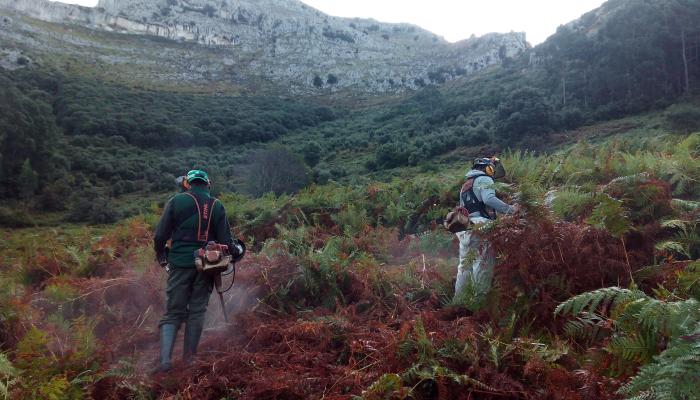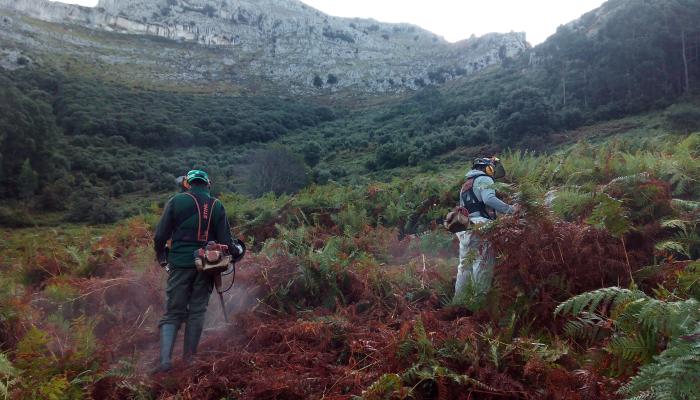
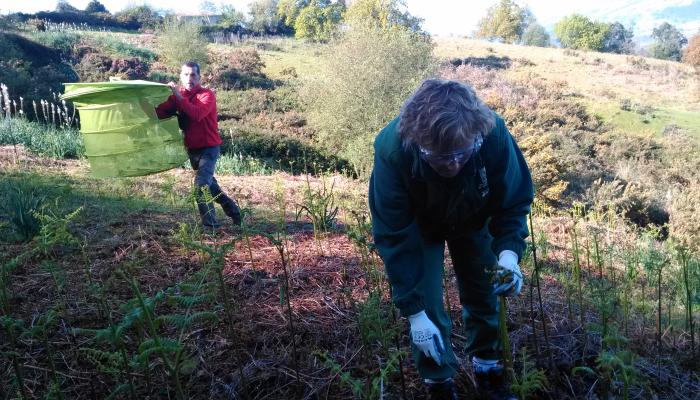
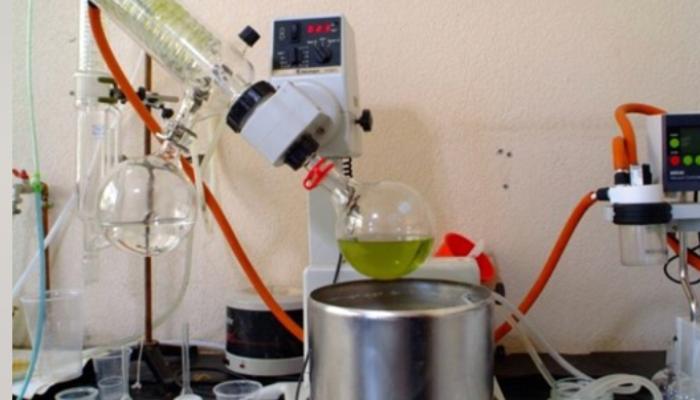
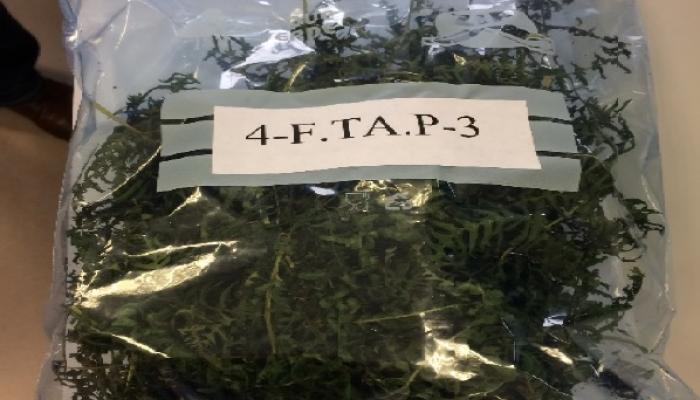

The objective of the Pteridum project was to analyze the economic viability of controlling common fern populations (Pteridium aquilinum) in a circular economy system adapted to climate change in the Cantabrian Mountains, and reducing forest fires caused or favored by their presence by controlling their expansion in an environmentally respectful way. In addition, some active ingredients have been obtained from the plant’s residue as a result of the elimination of the fern, such as ecdysone and its ecdysteroid counterparts, and studies have been conducted on the economic profitability of its commercialization for use as a biologically insecticide that is both economically profitable and ecologically proven.
Fern species of the genus Pteriidium are considered among the most successful invasive plants. In our case, the common fern (Pteridium aquilinum) is one of the most abundant plant species in the Cantabrian Mountains, and is also widely distributed. It is an indigenous species, with great adaptability to temperature, rainfall and locations, and which, under various circumstances, especially due to cultural factors or the lack of means for its elimination as in the past, makes it invasive, occupying the largest part of abandoned farmland, forests, etc. They are plants with a fast and strong growth, generating large shaded areas in the undergrowth.
As a highly flammable fuel, its large bushes are a real risk factor for the spread of forest fires in the event of drought.
On the other hand, the common fern has a great resilience against fire, which stimulates the germination of its spores and does not normally affect its rootstock, sprouting very easily after fires.
In addition to its great chemical and allelopathic arsenal, these distinctive characteristics favor its invasive and colonizing propagation before other also indigenous species and possibly less harmful to these effects, reducing the biodiversity in the area.
Therefore, based on these considerations, the main challenge of the project was to determine the economic viability of controlling common fern populations (Pteridium aquilinum) in certain locations of the Cantabrian Mountains, in a circular economy system adapted to climate change, as a valid replicable method of forest management. This would allow:
- reducing the risks of forest fires caused or favored by the presence of large masses of ferns
- controlling its expansion in an environmentally friendly way, through continuous selective mowing
- reducing the costs of these mowing and control tasks, by obtaining and recovering industrial products obtained from the removed material.
Based on the biological characteristics of the ferns and in accordance with the above, four fundamental specific objectives have been set for the execution of the project:
- Reduce forest fires caused or favored by the presence of Pteridium aquilinum (P. aquilinum) by controlling its expansion in an environmentally friendly way.
- Obtain the active ingredients of the vegetal residue resulting from the elimination of the ferns, determining the possible economic profitability of its commercialization for use as a biological insecticide.
- Develop a public awareness campaign to inform about the risks posed by the excessive proliferation of P.aquilinum in relation to the climate change situation, as well as its harmful effects on biodiversity and health (human and livestock health).
- Disseminate and share the results of the project as a basis for its application, replication and improvement.
To fulfill the proposed objectives, the measures adopted in the development of the project were the following:
- Elimination of fire risks in two experimental plots of 2 ha each, located in the towns of Colindres and Liendo, through:
- The removal of flammable material, with initial clearing and crushing of the ferns located in each of the plots. It was carried out in autumn, just at the end of the vegetative period of the plants, which therefore did not resprout until the following spring. The crushed biomass was degraded directly on the ground, contributing nutrients to it. This way, during part of the autumn and winter, the presence of dry ferns on the ground was avoided in the cleared areas, completely eliminating its high flammability potential.
- Preventing the reappearance of flammable material with the sprouting of the spring, at which time selective clearing was carried out periodically on both plots, organized by sector. After the clearing, it was observed that new regrowths were always present, even in sectors where the land was cleared three consecutive times (every 21 days). However, in the sectors most often cleared, the biomass was reduced considerably (approximately 75%), so new actions were proposed to extend the clearing period until August to deplete the rootstock reserves.
- Recovery actions, aimed at characterizing and extracting active ingredients from the fern plant residue and determining the possible profitability of its production and marketing as a biological insecticide. To do this, we proceeded to:
- Extract and quantify possible active ingredients that could be used as insecticides. The presence of significant amounts of ecdysone was determined in certain parts of the plant, with a high insecticidal capacity and harmless to vertebrates, plants and other organisms.
- Conduct bioavailability and biological activity studies of the content of ecdysteroids (β and α ecdysone) in the fern fronds. Specifically, neurotoxicity and efficacy studies were conducted using a human neuroblastoma line (IBBTEC) on various species of pest-causing insects (CSIC), such as aphids of the Myzus persicae and Rhopalosiphum padi species, the former being the most sensitive to extracts.
- Assess the market potential of these ecdysteroids as pesticides of natural origin for pest control and management. Thus, it is considered that there is a real opportunity for commercialization derived from new strategies and existing environmental legislation, as well as from new technologies capable of fueling new developments.
3.Public awareness campaign, conducted during the execution of the project through different undertakings in the field of communication, including the preparation of various materials, such as leaflets, posters or presentations, among others, as well as press releases for this purpose.
The different expected climate change scenarios represent a possible advantage for the propagation and proliferation of the great fern masses in the Cantabrian Mountains, given the high adaptability of the common fern Pteridium aquilinum. And, this possible increase in fuel biomass, especially in times of extreme drought, may constitute an intrinsic danger for the onset of forest fires in the area.
The development of a management and control system for common fern populations in this area constitutes a measure of local adaptation in a circular economy system, reducing forest fires caused or propagated by their presence in an environmentally respectful way.
The project idea came from the Bosques de Cantabria Cultural Association, an entity that coordinated the different actions carried out in the Association under the supervision of the Association of Sustainable Municipalities of Cantabria (MMSC).
The project had the support of the Biodiversity Foundation of the Ministry of Agriculture and Fisheries, Food and Environment and the collaboration of the Institute of Biomedicine and Biotechnology of Cantabria (IBBTEC), the Center for Environmental Research (CIMA) of the University and Research, Environment and Social Policy Department of the Government of Cantabria and the City Councils of Colindres and Liendo.
In this sense, the MMSC supported the technical and administrative management aspects of the project together with the Bosques de Cantabria Cultural Association, while the IBBTEC provided technical assistance for laboratory work and analysis.
The main problem in eliminating P.aquilinum populations is that its rhizome or rootstock is deeply buried and is very difficult to root out. If the land is plowed, the only thing that is achieved is the elimination of the accompanying plant life, leaving P.aquilinum at its full potential for resprouting with force and without any competition. The use of herbicides is also not advisable due to its high price and toxicity to the terrain. Thus, adopting other strategies is therefore necessary.
The application of selective clearing techniques was tested in this project, keeping the rest of the plants intact so that they may benefit from certain growth advantages that also contribute to providing shade to new shoots that may arise after clearing. The intention is thus to deplete the energy reserves of the rhizomes and repeating the process several times, so that the fern is ultimately depleted or at least produces stunted individuals with little mass of flammable material.
On the other hand, risk elimination actions entailing this type of clearing and control tasks imply high labor costs, leading to another specific point of interest of the project consisting in reducing said costs by obtaining and recovering the by-product obtained from the removed material. In this sense, the viability of the extraction of and obtaining a chemical product such as ecdysone will make application of this type of actions profitable. From the extracted ecdysteroids, a biological insecticide can be made that would allow fighting pests in crops or garden plants in an environmentally friendly manner, since it causes premature molting of insects but has no effect on other wildlife and vegetables.
The control of natural populations of Pteridium aquilinum has traditionally been carried out by applying herbicides (which is expensive and has undesirable effects in many cases), controlled fires (which sometimes have the opposite effect) or by periodic mowing (the best system, effective but expensive, given the cost of labor involved).
In addition, Pteridium aquilinum carries an important allelopathic chemical arsenal against other plant species in addition to a toxic one against many animal species, such as livestock in general and even humans (thiaminase, HCn, ptakyloside, ...). Some of these chemicals can be beneficial and usable, while contact with others can be particularly harmful occasionally.
In this sense, the greatest success of the project has been demonstrating the validity of the continuous selective mowing techniques for the control and propagation of ferns, reducing the implicit cost derived from these actions by leveraging the plant residue obtained for extraction and purification of chemical compounds such as ecdysone, which can be an important economic resource that adds value on these actions.
The determination, therefore, of the fern's own chemicals, their characterization and the extraction, purification and commercial formulation of those with an industrial interest, such as ecdysteroids, may be essential for the continued application of this control mowing of its biomass, as they reduce costs and enable the development of a local applied industry.
In terms of budget, the project amounted to a total cost of € 53,239.01, the financing of which was supported by the Ministry of Agriculture and Fisheries, Food and Environment through the Biodiversity Foundation, which contributed € 28,565.95 (53.66%).
The rest, € 24,673.06 (46.34%) were contributed by the Environmental Research Center (CIMA) of the Department of University and Research, Environment and Social Policy of the Government of Cantabria, which contributed with € 14,850.00 (27.83%) and by the Association of Sustainable Municipalities of Cantabria, which contributed € 9,050.00 (16.96%).
The budget items were allocated to personnel, travel and living expenses, external assistance, inventory, consumables and general expenses.
The development of this project is affected by the local and regional regulations on the exploitation of agricultural farms, as well as those on livestock, forest land and mountains of public utility.
The results of the project have been forwarded to the Government of Cantabria for assessment as part of the regional plans, strategies and management instruments.
On the other hand, the extraction of ecdysteroids from the obtained plant remains and the preparation and commercialization of potential natural insecticides from them imply an affection by broader national and international legislation on the use of biopesticides.
In this sense, biocides are regulated at European level by (EU) Regulation No. 528/2012 of the European Parliament and of the Council of May 22, 2012. However, each Member State authorizes separately the marketing of biocide products within its borders, although biocidal active substances are approved at the European Community level. In Spain, Royal Decree 971/2014 is the one that regulates the evaluation procedure of these plant protection products.
In any case, biocidal products may only be marketed and used in national territory if they have been previously authorized and registered in the Official Register of Biocidal Products. The list of approved active substances can be found at the European Agency for Chemical Substances and Mixtures (ECHA) and the procedure and requirements can be found at the D.G. of Public Health and Foreign Health of the Ministry of Health, Social Services and Equality.
The project had a duration of 10 months, from August 2017 to June 2018.
- Cooper-Driver GA.; Swain T. 1976. Cyanogenic polymorphism in bracken in relation to herbivore predation. Nature, Lond. 260: 604.
- Evans I.A.; Widdop B.; Jones R.S.; Barber G.D.; Leach R.; Jones D.L.; Mainwaring-Burton R. 1971. The possible human hazard of the naturally occurring bracken carcinogen. Biochem. J. 124(2): 29-30.
- Evans I.A. 1976. Relationship between bracken and cancer. Bot. J. Linn. Soc., 73: 105-112.
- Farnworth J.; Davies G.M. 1974. The improvement of bracken dominated hill pasture using herbicides, reseeding fertilizers and cutting. J. Agricult. Sc., 83(3): 557-562.
- Ferreira M.B.; Laca-Buendia J.P. del C. 1978. Espécies consideradas plantas daninhas em áreas cultivadas no Estado de Minas Gerais. Planta Daninha, 1(2): 16-26.
- Fletcher W.W.; Kirkwood R.C. 1979. The Bracken Fern (Pteridium aquilinum L. Kuhn.); its Biology and Control (p. 591-636). In: “The Experimental Bioolgy of Ferns”. A.F. Dyer (ed.). London. Academic Press, XVIII. 657 pp.
- Glass A.D.M. 1976. The allelopathic potential of plenolic acids associated with rizosphere of Pteridium aquilinum. Can. J. Bot, 54(2): 2440-2444.
- Hoehne F.C. 1939. Plantas e substâncias vegetais tóxicas e medicinais. São Paulo, Graphicars. 395 pp.
- Malavolta E. 1976. Manual de química agrícola; nutrição de plantas e fertilidade do solo. São Paulo, Ceres. Acidez do solo. pp: 327-331.
- Santos H.L.; Ferreira M.B.; D'Assunção W.R.C. 1975. Levantamento de plantas tóxicas para bovinas e suspeitas de serem tóxicas no Estado de Minas Gerais. Belo Horizonte. EPAMIG. 69 p.
- Ramírez Trejo M.R.; Pérez García B.; Orozco Segovia A.D. 2007. Helechos invasores y sucesión secundaria post-fuego. Ciencias, 85: 18-25.
- Javier Hernández Blanco
Director Técnico
Mancomunidad de Municipios Sostenibles de Cantabria
Correo electrónico: hernandez-j@municipiossostenibles.com
- Eduardo Clemente Rasines del Río
Presidente de la Asociación Cultural Bosques de Cantabria
Correo electrónico: info@bosquesdecantabria.org



